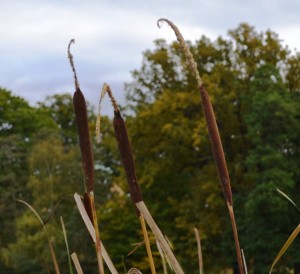Common names for plants, although easy to remember, can often be misleading. So is the case with the family Typhaceae, which contains the Cattails (accurately describing the classic and unmistakable cylindrical inflorescense). However more ambiguous are the alternative names such as Reed-mace (it is NOT a Reed – Poaceae – !) and Bulrush (it is NOT a rush – Juncaceae – either!). To add to the confusion, the common name Bulrush is also applied to many plants in the Sedge – Cyperaceae – family!
Common names aside, Typhaceae a wonderful group of plants both beautiful and useful. The characteristic inflorescence is particularly interesting because it is unisexual: the male flowers are distal (at the top end) and the female flowers are proximal (at the bottom end) of the cylinder.
Historically this was a very widely used plant. The young shoots can be eaten raw, the roostock boiled and eaten or ground and mixed with flour.
The seeds can be pressed for oils, and the soft fluff of the carpels was used for insulation or stuffing pillows. The shoots were also used for cattle fodder, and the leaves for weaving mats (PfF 2012).
These days the main household use is to put the preserved inflorescence on display in vases. They have also been planted in polluted wetlands as natural pollution absorbers (PfF 2012). Roots and shoots should not be eaten if they have a bitter flavour, as this may indicate polluted water.
Recently in the USA, concerns have begun to arise over this plant becoming an invasive species, as it can exclude other less competitive wetland plants, and so should be managed accordingly (PfF 2012).
All photographs by author. Shared under Creative Commons Non-Commercial License.
Reference:
Plants for a Future. 2012. Typha latifolia. Available from: http://www.pfaf.org/user/Plant.aspx?LatinName=Typha+latifolia [1/11/2012]


